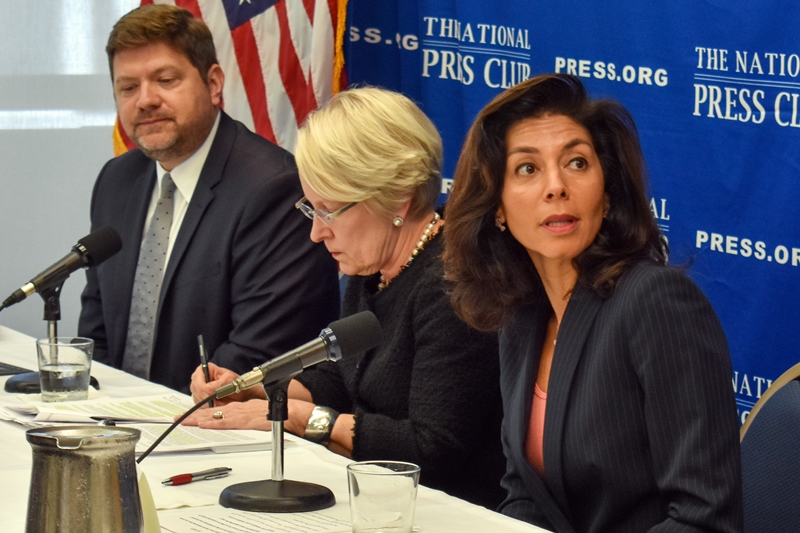Legal panel says changes to immigration courts create barriers to justice and due process
 Immigration judge Ashley Tabaddor, right, answers a question from National Press Club president Alison Kodjak. Photo: Alan Kotok
Immigration judge Ashley Tabaddor, right, answers a question from National Press Club president Alison Kodjak. Photo: Alan Kotok
An immigration lawyer, an immigration court judge and the president of the American Bar Association decried recent changes in the administration of immigration courts, calling them barriers to justice and due process, at a National Press Club Headliners Newsmaker event Sept. 27.
“Over the last three years, and in particular, the last few weeks, the Department of Justice has taken dramatic and revolutionary steps to dismantle the courts and strike at the very core of principles of justice that we as judges and Americans hold dear,” Ashley Tabaddor, president of the National Association of Immigration Judges, said.
Former Attorney General Jeff Sessions reversed four decades of precedent by removing immigration judges’ use of administrative closure, referral of cases to other agencies, such as Health and Human Services or the State Department, she said.
Her “four decades” referred to the 1983 creation of the Executive Office for Immigration Review (EOIR) within the Department of Justice.
This one act by Sessions added 300,000 cases to the backlog in immigration courts, she said.
In addition, DOJ has added quotas and deadlines that judges must meet at risk of their employment, and withheld staff support, equipment and interpreters, she said.
Club President Allison Fitzgerald Kodjak had noted as she introduced the panel that the case backlog is now over a million and that judges are required to handle 700 cases per year.
Tabaddor acknowledged that the original creation of courts within a law enforcement agency automatically created a conflict of interests, but that procedures had developed to mitigate them, such as separating the administrative management of the EOIR from the appellate function. These two functions have now been merged in one person, she said.
“This radical move essentially decimates any semblance of separation of the judicial role of immigration judges from the law enforcement policy agenda of the Department of Justice.” she said.
Finally, the DOJ has filed a petition with the federal authority to decertify the immigration judges’ union, she said.
Judy Perry Martinez, president of the American Bar Association, said the ABA favors separating the immigration courts from the Department of Justice by making them Article I courts.
Legislative courts, such as tax courts, have been established under Article I of the Constitution, which enumerates legislative functions, including “to establish an Uniform Rule of Naturalization.”
She described pro bono work she has done at the border in Brownsville, Texas. “I saw something that does not in any way approach justice," she said.
She noted that lawyers wanting to assist asylum seekers who are required to await court action in Matamoros, Mexico, would need to travel to that city, which the state department ranks as equally dangerous as Syria or Afghanistan.
She observed a tent court in Brownsville where judges do not physically appear, but hear cases via video. Asylum seekers are allowed only to bring the document requiring them to appear; they are not allowed to bring a pen or paper, she said.
Jeremy McKinney, second vice president of the American Immigration Lawyers, said, “It’s clear that these tent courts are designed to create a deportation machine ... with little regard for due process.”
